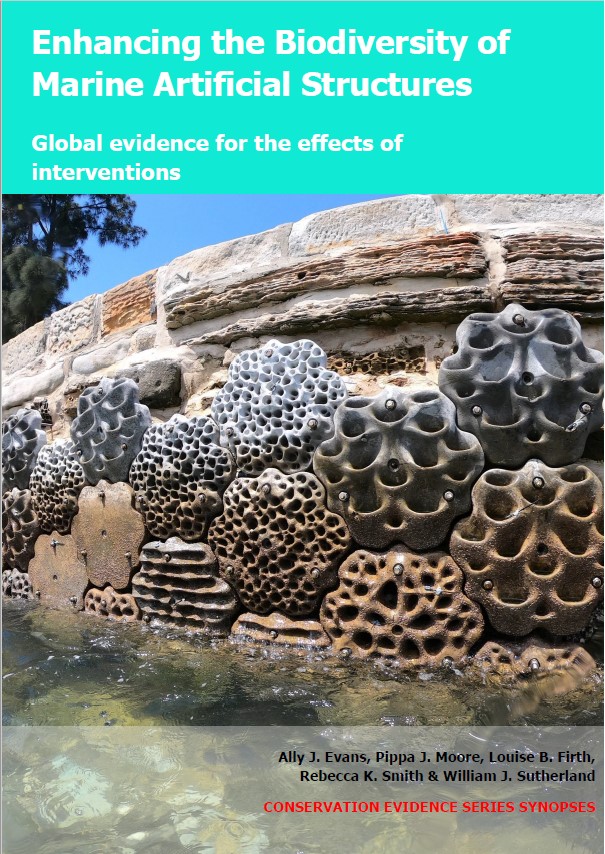Manage or restrict harvesting of species on subtidal artificial structures
-
Overall effectiveness category Awaiting assessment
-
Number of studies: 3
View assessment score
Hide assessment score
How is the evidence assessed?
-
Effectiveness
not assessed -
Certainty
not assessed -
Harms
not assessed
Study locations
Supporting evidence from individual studies
A replicated, randomized study in 2001–2002 on subtidal breakwaters and groynes in five sites on open coastline in the Adriatic Sea, Italy (Airoldi et al. 2005) reported that making access to the breakwaters illegal did not prevent people from harvesting invertebrates and fishes on and around them. At four sites, an average of 0–2 harvesters/2-hour survey were recorded on breakwaters, despite access being illegal. At one site where breakwaters (access illegal) and groynes (access legal) were studied simultaneously, an average of 0–5 harvesters/2-hour survey were recorded. At this site >70% of observations were on groynes, but harvesting also occurred on breakwaters (details not reported). Harvesting species on breakwaters was restricted by making access illegal, but with no apparent enforcement (timing and other details not reported). The number of people harvesting invertebrates and fishes on breakwaters at each of five sites was counted during 2-hour surveys on 152 randomly-selected days between November 2001 and November 2002. Observations at one of the sites included harvesting on groynes, to which access was legal.
Study and other actions testedA site comparison study in 2002–2003 on three subtidal breakwaters on open coastline in the Adriatic Sea, Italy (Guidetti, Bussotti & Boero 2005; same experimental set-up as Guidetti et al. 2005) found higher abundances of white seabream Diplodus sargus, two-banded seabream Diplodus vulgaris and gilt-head seabream Sparus aurata, but similar abundance of sea urchins Paracentrotus lividus around a breakwater with restricted harvesting, compared with two unrestricted breakwaters. Sixteen years after harvesting restrictions were introduced, abundance was higher around the breakwater with restrictions than those without for white seabream in two of four surveys (restricted: 5–8 individuals/125m2; unrestricted: 0–2/125m2) and for two-banded seabream in three surveys (restricted: 2–46/125m2; unrestricted: 0–14/125m2). In the remaining surveys, abundances were similar around restricted (white: 3–10/125m2; two-banded: 4/125m2) and unrestricted breakwaters (white: 0–8/125m2; two-banded: 1–3/125m2). Gilt-head seabream were present only at the restricted breakwater in three of the surveys (1–2/125m2) and was more abundant in the fourth (restricted: 2/125m2; unrestricted: <1/125m2). Urchin abundance was similar around restricted and unrestricted breakwaters (both 2–11/20m2). Harvesting species on and around a boulder breakwater was restricted by creating a marine protected area in 1986, making fishing illegal with successful enforcement. Fishes and sea urchins were counted during four surveys at 4–7 m depth in 2002–2003 around the breakwater with restricted harvesting and around two nearby breakwaters with no restrictions.
Study and other actions testedA site comparison study in 2002–2003 on three subtidal breakwaters on open coastline in the Adriatic Sea, Italy (Guidetti et al. 2005; same experimental set-up as Guidetti, Bussotti & Boero 2005) found higher fish species richness and different fish community composition around a breakwater with restricted harvesting, compared with two unrestricted breakwaters, while fish abundances varied depending on the species and survey date. Sixteen years after harvesting restrictions were introduced, the fish species richness was higher around the breakwater with restrictions (24–27 species/breakwater) than those without (13–22/breakwater) and the fish community composition differed in seven of eight comparisons (data reported as statistical model results). Total fish abundance was higher around the restricted breakwater in only one of four surveys (152 vs 63–66 individuals/survey) but was similar in three (319–554 vs 192–841/survey). However, the individual abundances of eight of 12 fish species were higher around the restricted breakwater during two or more surveys (see paper for full results). Three fish species recorded around the restricted breakwater were absent from unrestricted breakwaters. Harvesting species on and around a boulder breakwater was restricted by creating a marine protected area in 1986, making fishing illegal with successful enforcement. Fishes were counted during four surveys at 4–7 m depth in 2002–2003 around the breakwater with restricted harvesting and around two nearby breakwaters with no restrictions.
Study and other actions tested
Where has this evidence come from?
List of journals searched by synopsis
All the journals searched for all synopses
This Action forms part of the Action Synopsis:
Biodiversity of Marine Artificial Structures
Biodiversity of Marine Artificial Structures - Published 2021
Enhancing biodiversity of marine artificial structures synopsis





)_2023.JPG)














